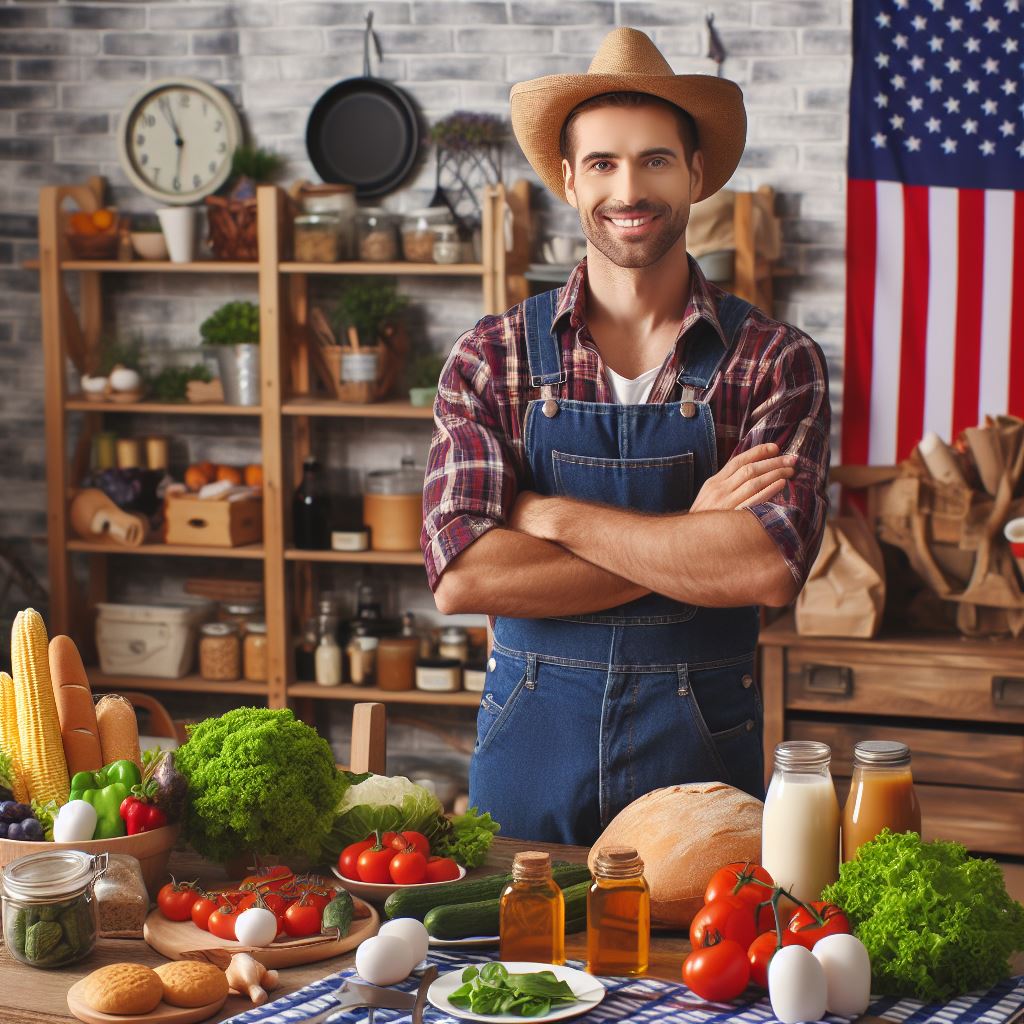Local Foods Impact: A Consumer’s Guide
Last Updated on March 2, 2024
Introduction
Welcome to our blog section on the impact of local foods on consumers.
In this post, we will explore the importance of consuming local foods and discuss the purpose of this blog.
Eating local foods supports local farmers, reduces environmental impact, and provides fresher and more nutritious options.
The purpose of this blog post is to raise awareness about the benefits of choosing local foods and to encourage consumers to make informed decisions about their food choices.
By understanding the impact of local foods, consumers can contribute to their local communities and make healthier choices.
This blog section aims to provide valuable information and insights to help individuals make more informed decisions when it comes to supporting local food systems.
Through this post, we hope to empower consumers to actively seek out local food options and contribute to a more sustainable and resilient food system.
So stay tuned for the next sections of this blog section, where we will delve deeper into the benefits of local foods and provide practical tips on how to incorporate them into your daily life.
Together, we can make a positive impact on our communities and the environment by supporting local food producers.
Benefits of Local Foods
When it comes to choosing what to put on our plates, the benefits of consuming local foods cannot be ignored.
From freshness and taste to nutritional value and support for the local economy, local foods offer a multitude of advantages.
Let’s delve into these benefits further:
Freshness and Taste
Local foods are known for their superior freshness, as they are harvested at their peak ripeness and often travel a shorter distance to reach consumers.
This means that they are more likely to retain their flavors and nutrients, resulting in a delightful taste experience.
Nutritional Value
Compared to their commercially produced counterparts, local foods are generally recognized for their higher nutritional value.
Fruits and vegetables that are allowed to ripen naturally on the vine tend to contain more vitamins, minerals, and antioxidants.
Support for Local Economy
Choosing local foods is a way to direct our food dollars back into the local economy.
By supporting local farmers, we help them stay in business, strengthen our community, and create job opportunities. It’s a win-win situation for both consumers and producers.
Reduced Carbon Footprint
Opting for local foods significantly reduces the carbon footprint associated with food production and transportation.
Locally sourced foods require fewer miles to travel compared to foods that are shipped across the country or imported from overseas.
This leads to a significant decrease in greenhouse gas emissions, benefiting the environment.
Preserving Biodiversity
Local foods promote the preservation of biodiversity by supporting the cultivation of diverse agricultural varieties.
Local farmers often grow heirloom or traditional varieties that may not be found in large-scale commercial operations.
By consuming these unique products, we contribute to the preservation of genetic diversity and help protect endangered plant species.
Incorporating local foods into our diets does not only benefit us as individuals but also extends positive effects to our community and the environment at large.
By consciously making these choices, consumers hold the power to enact meaningful change.
In fact, the numerous benefits of local foods are undeniable. From the enhanced freshness and taste to the nutritional value they offer, local foods truly stand out.
Additionally, they contribute to the support of our local economies, aid in reducing carbon emissions, and help preserve biodiversity.
By supporting local producers, consumers can embrace a sustainable future while enjoying the delicious flavors and health benefits only local foods can provide.
So, why not incorporate more local foods into your diet?
Join the movement towards sustainable eating and make a positive impact on your health, community, and the environment.
Finding Local Foods
In today’s world, where the food system has become globalized, finding local foods can be challenging.
However, there are several options available for consumers who are interested in supporting local farmers and enjoying fresh, seasonal produce.
Ways to find local foods
Here are some ways to find local foods:
- Farmers markets: These vibrant community spaces bring farmers and consumers together. They offer a wide variety of locally grown fruits, vegetables, meats, dairy products, and artisan goods.
- Community-supported agriculture (CSA): Joining a CSA allows consumers to have direct access to locally produced food. Subscribers pay a membership fee and receive a box of fresh, seasonal produce each week.
- Farm-to-table restaurants: These establishments prioritize sourcing ingredients from local farmers. By dining at farm-to-table restaurants, consumers support local food producers and enjoy meals made with fresh, high-quality ingredients.
- Local grocery stores: Many communities have independent grocery stores that focus on sourcing products from local farmers. These stores often highlight locally produced items and support the local economy.
- Online platforms: With the rise of e-commerce, consumers can now find local farmers and their products online. Websites and mobile apps connect buyers directly with farmers, allowing them to purchase fresh produce and other local goods.
These options provide consumers with opportunities to make conscious choices about where their food comes from.
By supporting local farmers, consumers can have a positive impact on the environment, their communities, and their own health.
Additional benefits of choosing local foods
Here are some additional benefits of choosing local foods:
- Fresher and more flavorful: Local foods are often harvested at their peak ripeness and brought to market quickly, ensuring superior taste and texture.
- Nutritious: Locally grown produce tends to retain more nutrients since it doesn’t need to be transported long distances or stored for extended periods.
- Reduced environmental impact: Buying local reduces the carbon footprint associated with the transportation of food, as well as the need for packaging materials.
- Support for the local economy: When consumers buy local, their money stays within the community, supporting local farmers and businesses.
- Preserving farmland and biodiversity: Supporting local agriculture helps maintain farmland and protects open spaces from development, preserving biodiversity.
- Connection to the community: Visiting farmers markets or joining a CSA fosters a sense of community and allows consumers to build relationships with local farmers.
- Awareness of food sources: Choosing local foods encourages consumers to learn about the seasonality of produce and the farming practices used in their area.
In essence, finding local foods is not as difficult as it may seem.
By exploring farmers markets, CSAs, farm-to-table restaurants, local grocery stores, and online platforms, consumers can easily access fresh, locally produced food.
Choosing local foods offers numerous benefits, including better taste, increased nutrition, reduced environmental impact, and support for the local economy.
So, why not start exploring your local food options today and make a positive impact on both your plate and your community?
Read: Organic Trends in Farm-to-Table Dining
Understanding Labels
Certified organic
Sustainable farming practices: Look for labels like “Rainforest Alliance Certified” or “Fair Trade” to support environmentally friendly and socially responsible farming methods.
Certified organic foods are produced without synthetic pesticides, which can be harmful to human health.
By choosing organic products, consumers can reduce their exposure to harmful chemicals that are commonly used in conventional farming.
The USDA Organic seal guarantees that a product contains at least 95% organic ingredients, with the remaining 5% meeting strict standards.
Non-GMO
Non-GMO foods are free from genetically modified organisms, which are organisms that have been altered using genetic engineering techniques.
Genetically engineered crops have potential risks, such as increased pesticide use and the creation of herbicide-resistant superweeds.
The Non-GMO Project Verified seal provides assurance that a product has been rigorously tested and verified to be free from genetically engineered ingredients.
Locally sourced
Locally sourced foods are often fresher and support local farmers, reducing the carbon footprint associated with long-distance transportation.
Buying local helps to build a stronger community and ensures that small-scale farmers can continue to thrive.
Look for farmers’ markets or community-supported agriculture (CSA) programs to find locally sourced foods in your area.
Sustainable farming practices prioritize the long-term health of the environment, communities, and animals.
Certifications like “Rainforest Alliance Certified” indicate that the food is produced using methods that protect biodiversity and promote the well-being of workers.
“Fair Trade” labels ensure that farmers and workers receive fair wages and have safe working conditions.
Supporting sustainable farming practices helps to protect ecosystems, conserve resources, and preserve the planet for future generations.
In brief, understanding food labels is crucial for making informed choices about the products we consume.
Certified organic and Non-GMO labels guarantee that the foods are produced without harmful chemicals and genetic modification.
Locally sourced foods support local farmers and reduce transportation emissions.
Choosing products with sustainable farming certifications promotes environmental and social responsibility.
By understanding labels, consumers can prioritize their health, support local economies, and contribute to a more sustainable food system.
Read: Farm-to-Table 101: Basics of Farm-Fresh Eating
Connecting with Local Farmers
One way to support local farms is by connecting directly with the farmers in your community.
Building relationships
Building relationships with local farmers is essential for fostering a sustainable and resilient food system.
By getting to know the farmers who grow your food, you can gain a deeper appreciation for the hard work and dedication they put into their craft.
Visiting local farms
Visiting local farms is an excellent way to establish a personal connection with the people who produce your food.
It allows you to see firsthand how they operate and witness the care and attention they give to their crops and livestock.
Attending farm events
Farm events, such as farmers’ markets and farm tours, provide unique opportunities to engage with local farmers and their products.
These events often feature a wide variety of fresh produce, artisanal goods, and other local products.
By attending them, you not only support local farmers but also discover new flavors and foods that you may not find in conventional grocery stores.
Additionally, farm events allow you to meet fellow community members who are passionate about local foods and exchange valuable knowledge and experiences.
Joining community gardens
Community gardens offer an incredible chance to participate actively in the local food movement.
By joining a community garden, you can learn valuable gardening skills and contribute to the production of fresh, nutritious food.
Gardening alongside experienced growers provides an excellent opportunity for knowledge sharing and building strong community bonds.
Moreover, community gardens often organize workshops and events that promote sustainable practices and educate individuals about the benefits of local foods.
The Benefits of Connecting with Local Farmers
- Access to fresh and seasonal produce that is picked at the peak of ripeness.
- Reduced environmental impact as local foods travel shorter distances, reducing carbon emissions.
- Support for local economy and small-scale agriculture, contributing to regional food security.
- Transparency in food production, allowing you to know where your food comes from and how it is grown.
- Promotion of biodiversity by supporting diverse farming practices and heirloom varieties.
- Opportunities for trying new and unique foods that are specific to your region.
- Development of a stronger sense of community and connection with the people who produce your food.
In review, connecting with local farmers is a powerful way to support sustainable agriculture and foster a healthy food system for both individuals and communities.
By building relationships, visiting local farms, attending farm events, and joining community gardens, consumers can actively contribute to a thriving local food movement.
Not only do these actions benefit our health and the environment, but they also strengthen community ties and promote a more resilient and sustainable food system for future generations.
Read: Seasonal Guide to Vegetable Farming Success

Overcoming Challenges
In today’s blog section, we will discuss the challenges faced by consumers when it comes to local foods and how to overcome them.
Local foods have gained popularity in recent years due to their numerous benefits, such as supporting the local economy, reducing environmental impact, and providing fresher and healthier options.
However, several challenges hinder consumers from fully embracing local foods, including seasonal limitations, affordability, limited availability, and lack of awareness.
Overcoming Seasonal Limitations
- Embrace the concept of eating seasonal produce, which can be flavorful, nutritious, and cost-effective.
- Learn about preserving techniques like canning, dehydrating, and freezing to enjoy local produce throughout the year.
- Support local farmers by purchasing their produce and products even during off-seasons, thereby encouraging year-round production.
Affordability
- Budget and plan your expenses to allocate a portion for purchasing local foods.
- Buy in bulk during peak seasons and preserve the surplus for later use, saving both money and access to local foods.
- Consider joining a community-supported agriculture (CSA) program, where you can receive a variety of local produce at a discounted price.
Limited Availability
- Research local farmers’ markets, food hubs, and co-ops in your area to discover local food sources.
- Establish relationships with local farmers to get updates on their availability and diverse offerings.
- Explore online platforms that connect consumers directly with local producers, expanding your options beyond your immediate surroundings.
Lack of Awareness
- Educate yourself about the benefits of local foods, such as their freshness, nutritional value, and reduced environmental impact.
- Stay informed about local food events, workshops, and initiatives in your community, which can help increase your awareness.
- Share your knowledge and experiences about local foods with friends, family, and colleagues to create a ripple effect and inspire others.
By understanding and addressing these challenges, consumers can have a positive impact on their local food systems.
Supporting local foods not only benefits individual health but also contributes to the overall wellbeing and sustainability of the community.
It fosters a closer connection between consumers and producers, improving food security, fostering a sense of community, and empowering local economies.
In general, while there are challenges to overcome, the rewards of embracing local foods are substantial.
By acknowledging the seasonal limitations, finding ways to afford local foods, seeking out available sources, and raising awareness, consumers can overcome these obstacles and reap the benefits of a locally sourced and sustainable food system.
Let us all be conscious consumers and make a difference in our communities by supporting local foods!
Read: Precision Agriculture: Tech in Crop Cultivation
Learn More: 2024’s Top Farm-to-Table Workshops Nationwide
Supporting Local Food Systems
Choosing to support local food systems can have a significant impact on both the environment and your community.
By sourcing your food locally, you can help reduce carbon emissions, support local farmers, and enhance the quality of the food you consume.
Here are some ways you can actively promote and engage in local food systems:
- Shop at farmers markets: Visit farmers markets in your area to buy fresh, seasonal produce, and support local farmers directly.
- Join a Community Supported Agriculture (CSA) program: CSA programs allow you to receive a share of a local farm’s harvest throughout the growing season, fostering a direct relationship between you and the farmer.
- Patronize local restaurants and businesses that prioritize local sourcing: Choose to dine at restaurants that feature local, sustainable ingredients on their menus, and support local food producers and distributors.
- Grow your own food: Create your own mini farm in your backyard or balcony by growing vegetables, herbs, and fruits. This allows you to enjoy the freshness of homegrown produce while reducing your carbon footprint.
- Support local food cooperatives: Join or shop at a local food co-op where you can find a wide variety of organic and locally sourced products.
- Participate in community gardens: Get involved in local community gardens where you can rent a plot or volunteer your time to grow fruits and vegetables collectively.
- Promote farm-to-school programs: Advocate for farm-to-school programs in your local schools to ensure that students have access to fresh, nutritious meals made from locally sourced ingredients.
Volunteer Opportunities
Volunteering your time in support of local food systems not only benefits your community but also provides you with valuable experiences and knowledge.
If you’re passionate about sustainable agriculture and healthy food, consider the following volunteer opportunities:
- Helping at a farmer’s market: Assist in setting up and running a farmer’s market by greeting customers, handling transactions, or organizing events.
- Volunteering at a community garden: Get your hands dirty and help maintain community gardens by watering plants, weeding, or organizing educational workshops.
- Supporting food rescue organizations: Volunteer at local food banks or organizations that collect excess food from farmers and distribute it to those in need.
- Assisting with farm work: Offer your assistance to local farmers by helping with planting, harvesting, or tending to animals.
- Teaching gardening skills: Share your knowledge by offering gardening workshops or volunteering at schools to teach students about sustainable farming practices.
Advocacy and Policy
Getting involved in advocacy and policy initiatives is an essential part of supporting local food systems and driving positive change.
Here are some ways you can advocate for policies that promote sustainable agriculture:
- Support local food initiatives: Participate in local government meetings or community forums to express your support for policies that promote local food systems.
- Write to your representatives: Contact your elected officials to express your views on sustainable agriculture and encourage them to support legislation that benefits local food systems.
- Join food policy councils: Engage in or initiate local food policy councils to support small-scale farmers, markets, and inclusive food access in your community.”
Sharing Experiences on Social Media
Social media platforms provide an opportunity for you to share your experiences and knowledge about local food systems with a broader audience.
Here’s how you can make a difference through social media:
- Share pictures and stories: Post pictures of your locally sourced meals, visits to farmers markets, or gardening adventures to inspire others to support local food systems.
- Engage with local food-related content: Follow and interact with social media accounts dedicated to local food initiatives, sustainable farming, and environmental advocacy.
- Participate in online discussions: Join and contribute to online communities that focus on local food systems, sharing your experiences and learning from others.
Spreading the Word
Promote the importance of backing local food systems to drive change and inspire others.
Use these methods to raise awareness:
- Host workshops or talks: Organize educational events in your community to raise awareness about the importance of local food systems and sustainable agriculture.
- Share resources: Create and distribute informational flyers or brochures about local food systems, including where to find local farmers and markets.
- Start a blog or vlog: Share your knowledge and experiences through online platforms, offering tips, recipes, and insights into supporting local food systems.
- Collaborate with local organizations: Partner with local environmental or community organizations to organize events or campaigns that promote local food systems.
By actively engaging in these activities, you can become a powerful advocate for local food systems and contribute to a more sustainable and community-driven future.
Conclusion
Local foods have a significant impact on both the consumer and the environment.
By supporting local food systems, consumers can enjoy numerous benefits for their health, the local economy, and the planet.
Throughout this guide, we have discussed how consuming local foods can promote better health and overall well-being.
Local foods are also fresher, tastier, and more sustainable than their commercially produced counterparts.
We encourage consumers to embrace local foods and explore the abundance of options available in their local communities.
By doing so, they support local farmers and businesses, while also enjoying the superior taste and nutritional value of fresh, locally grown produce.
It is crucial for individuals to take action and support local food systems.
By shifting a portion of their purchasing power towards local farmers, consumers can create a stronger and more sustainable food system that benefits everyone involved.
Whether it’s shopping at farmers markets, joining community-supported agriculture programs, or simply buying directly from local producers, every effort matters in building a resilient and environmentally friendly food system.
Together, we can make a positive impact on our health, communities, and the planet.


